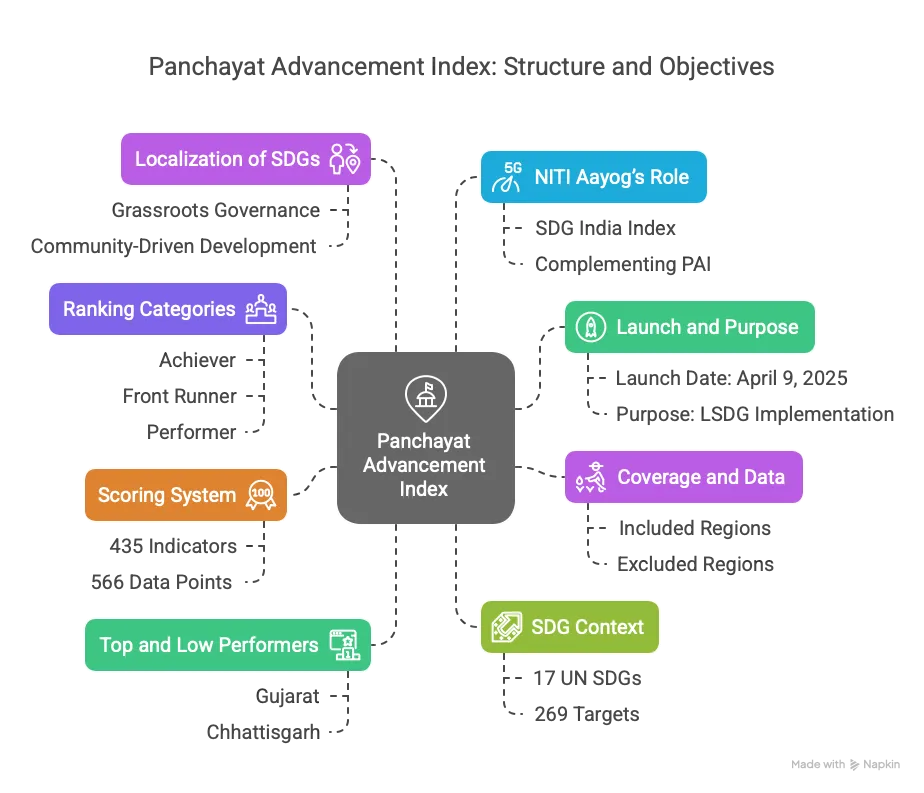UPSC
Indian Express Concise
Panchayat Advancement Index: Assessing Rural Governance for SDG Localization
Last Updated
11th April, 2025
Date Published
11th April, 2025
Share This Post With Someone


- Launch Date: The Panchayat Advancement Index (PAI) was launched on April 9, 2025, by the Ministry of Panchayati Raj (MoPR).
- Purpose: A multi-dimensional index to evaluate the performance of gram panchayats in implementing Localized Sustainable Development Goals (LSDGs) for holistic rural development.
- Coverage: Assesses 2.16 lakh gram panchayats across 29 states and Union Territories, out of India’s total 2.55 lakh panchayats.
- Non-Included Regions: Data from 11,712 gram panchayats in five states/UTs (Meghalaya, Nagaland, Goa, Puducherry, West Bengal) was excluded due to lack of state validation.
- Uttar Pradesh Data: Out of 57,702 gram panchayats in Uttar Pradesh, only 23,207 provided validated data.
- Nine Themes of Assessment:
- Poverty-free and enhanced livelihoods
- Healthy panchayat
- Child-friendly panchayat
- Water-sufficient panchayat
- Clean and green panchayat
- Self-sufficient infrastructure
- Socially just and socially secured panchayat
- Good governance
- Women-friendly panchayat
- Scoring System: Panchayats scored on a 0–100 scale based on 435 local indicators and 566 unique data points aligned with the National Indicator Framework.
- Ranking Categories:
- Achiever: 90–100 (no panchayats qualified)
- Front Runner: 75–90 (699 panchayats, 0.3%)
- Performer: 60–75 (77,298 panchayats, 35.8%)
- Aspirant: 40–60 (1,32,392 panchayats, 61.2%)
- Beginner: Below 40 (5,896 panchayats, 2.7%)
- Top Performers: Gujarat led with 346 Front Runner panchayats, followed by Telangana (270) and Tripura (42).
- Low Performers: Chhattisgarh had the highest number of Beginner panchayats (1,449), followed by Uttar Pradesh (1,237).
- SDG Context: Aligns with the 17 UN Sustainable Development Goals (SDGs) set in 2015 for 2030, covering 269 targets and 231 indicators, including no poverty, zero hunger, and climate action.
- Localization of SDGs: Emphasizes adapting SDGs to local contexts, with panchayats as key agents of grassroots governance.
- NITI Aayog’s Role: Tracks state-level SDG progress through the SDG India Index since 2018, complementing PAI’s focus on panchayats.
- Data Validation: Panchayats submit data via the PAI portal (www.pai.gov.in), validated by states/UTs for accuracy.
- Significance: Enables evidence-based planning, identifies development gaps, and fosters competition among panchayats to improve SDG outcomes.
- Expert View: Abha Samaddar, Principal Secretary (Civil Defence), Uttar Pradesh, stated PAI is a crucial step for fast-tracking SDG localization at the grassroots level.
- Collaboration: Developed with inputs from Union Ministries, state governments, and UN agencies.
- Objective: Enhances transparency, accountability, and community-driven rural development to meet the 2030 SDG agenda.
Glossary:
- Panchayat Advancement Index (PAI): A tool to measure gram panchayat performance in achieving localized Sustainable Development Goals.
- Sustainable Development Goals (SDGs): 17 global goals set by the UN in 2015 for 2030 to address poverty, inequality, and environmental challenges.
- Localization of SDGs (LSDGs): Adapting global SDGs to local contexts for effective implementation at the grassroots level.
- Gram Panchayat: The lowest tier of rural local self-government in India, responsible for village-level administration.
- National Indicator Framework: A set of metrics developed by the Ministry of Statistics to monitor SDG progress in India.
Link To The Original Article – https://indianexpress.com/article/explained/panchayat-advancement-index-faq-ranking-9937042/